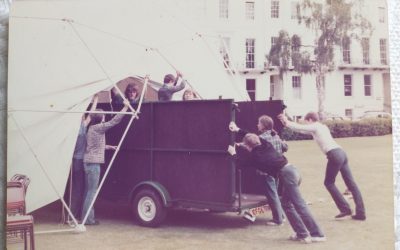A friend told me a tale of a violinist friend of his who came across a mass-produced violin for sale on eBay for €23. It was even cheaper than it sounds because the price included the violin, a bow, and a case.
He bought the violin, which arrived with a set of terrible strings, so he put on a new set of strings, but that was his only intervention. Then he set about asking people to compare the sound of him playing his own (fine old valuable) violin with the sound of him playing the €23 instrument (in both instances with his own good violin bow). As you might already suspect, not everyone could tell the difference. In a small room, people were pretty sure which was the fine old violin. But in a larger room or a more resonant hall, people often guessed wrongly. He found this distressing.
As a pianist, the result didn’t surprise me, because like (almost) all pianists I have to play different pianos in different venues. I can’t afford to become dependent on the sound of a particular piano, or to think that I cannot ‘sound like me’ on a different instrument. For me, it’s not so much the sound but the way of playing which identifies a pianist. It’s timing, phrasing, the balance between right and left hand. It’s the layering of voices, the approach to tempo, the use of the pedal. All these things can be transferred to whatever piano you’re playing.
I can’t pretend that pure sound quality doesn’t play a part, because some pianos just do sound better than others, but most pianists eventually achieve a Zen-like non-attachment to the sonority of particular pianos. If I think of pianists I know, and whether I could identify them if they played the piano behind a screen, it’s not really ‘their sound’ I’d recognise but rather a composite of elements amounting to what they do musically.
Actually, the same is true of string players, at least in my view. I feel I recognise them from their way of playing on whatever instrument they play. But they generally say that they only feel truly themselves on the instrument which they play every day and in every concert. They are HMHV (Half Man Half Violin).
I have mixed feelings when witnessing this bond. Perhaps I’m just envious, because there’s nothing quite like that for a pianist. But on the whole I feel afraid for them, because basing your musical happiness on the possession of a particular instrument is obviously a fragile thing. I feel they should all perform occasionally on a €23 violin.




I read an article in the Radio Times many years ago about a feature they did on Nigel Kennedy. They wanted to film him smashing a violin, so they bought the cheapest one they could find – “practically free with a cracker” was the exact phrase. Before they got to the point of filming that he picked the thing up and played it. The producers were amazed by the quality of the sound.
Anecdotes like this are often cited to prove that “it’s not the instrument, it’s you” and “a bad workman blames his tools”. But Kennedy doesn’t play a free-with-a-cracker violin at the Festival Hall. He plays his Strad.
I think it takes a remarkable artist to make good music from a poor instrument, and giving children poor-quality instruments to learn on can do more than anything to put them off. (Even my teacher couldn’t get the bottom notes out of my flute.)
Which is a slightly different point from the one you were making, but hey, it’s Friday.
Morag, thank you for making the important point that young people should not be put off learning an instrument by being given a poor-quality instrument. This is, as you said, a slightly different point from the one I was making but it’s good you reminded us of it.
I think a crucial part of this story might be that he used his own bow for playing both instruments. A fine player with a fine violin will almost certainly have a fine bow. I know that when I travel to places where I need to borrow a violin, I try to take one of my bows. To me this story also demonstrates that a good bow can help a fine player make a convincing sound on a poor violin – the bow is what makes the instrument breathe and sing. From personal experience, it is entirely possible to perform in a professional setting without anyone noticing that you are playing an inexpensive factory made violin. Following an accident to my left arm, when I was just getting back into playing, I once led a Beethoven st qt concert, in front of professional colleagues, using a 3/4 size violin outfit that I had bought for a pupil (including a student quality bow). No-one even noticed it wasn’t full-size and afterwards I had lots of comments about the wonderful sound my violin made…
One of the soloists at the Orpheus and Bacchus festival in France this June had broken the bridge on her baroque violin and found a modern violin made in China for a fiver in a charity shop – she still managed to play beautiful music on it, though it buzzed and complained a bit about the Mystery Sonatas…. Actually, to my ears, it had a baroquey frisson about the sound, not all smooth and romantic… next (and very last) festival is Sept http://orpheusandbacchus.com/vendange-festival/
I’m sorry to hear the festival is coming to an end this year. An interesting place! We need these little independent festivals.
Back on the subject of children (or beginners) and instruments. I recall the mother of my goddaughter telling me that she was perturbed that her daughter never won anything at the music festivals she was entering, even though she worked hard at her violin playing. Then she had a look at the instruments the other children were playing.
She went herself to a shop in London and tried out 3/4 size violins unti she found one within budget that was a much higher quality than the one Fiona had been playing. She presented Fiona with this instrument, and Fiona promptly won something at the Ayrshire Festival.
Now me, I have a £450 entry-level plastic baroque flute. It’s not a bad instrument (even that isn’t cheap!) and I’m making progress. But this afternoon (I’m a NORVIS in Durham) I had the chance to play a £1,675 Wenner instrument. (http://www.earlymusicshop.com/product.aspx/en-GB/1002861-wenner-rottenburgh-flute-boxwood-a-415) I think I’m in love! I found I could make music on that, even at my relative beginner level, far more easily and more beautifully than I possibly can on the plastic Aulos.
Indeed, I think the difference is far more noticeable in my playing than in the tutor’s playing. She can get a good performance out of the Aulos. I can’t, not really. I can from the Wenner. I was also getting far more enjoyment out of playing.
But how can an amateur beginner possibly justify spending that sort of money on an instrument? Catch 22.